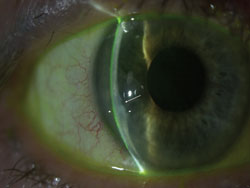Carefully perform slit lamp exam 1 day after cataract surgery
Cataract Surgery
Click Here to Manage Email Alerts
|
|
|
With advances in surgical techniques, your 1-day postoperative surgery patients will walk into your office looking normal to the naked eye. Eye patches and eye shields are no longer required, and it is rare to see injection or soft tissue swelling. Patients are generally thrilled about their experience thus far. However, this is the earliest and most critical stage of healing. It is our job to comanage their postoperative care, share in their excitement and educate them along the way.
The focus of our last column was checking visual acuity and pressure at the 1-day visit. Now we will move on to the slit lamp examination.
Checking IOL position
The lens should be posterior to the iris, well centered and no more posterior than about 2 mm behind the iris. If the pupil is undilated the day after surgery, the exact centration of the IOL can be more difficult to determine, but as long as the edge of the IOL is not visible in the pupillary space the centration is adequate.
 Slit lamp photo 1-day postop after cataract removal: A break in Descemet’s membrane (arrow) is visible at the site of the main cataract incision. The break allows fluid ingress into the cornea, resulting in corneal edema with associated thickening (space between arrowheads). Image: Geis T |
A decentered IOL could indicate a rupture of the capsule peripherally with displacement of the IOL through the tear in the capsule. It can also be a sign that one haptic of the IOL is in the bag and the other haptic is anterior to the anterior capsule in the sulcus. IOL position should not be too far posterior; if it is, this could indicate a posterior capsular rupture and an unstable lens. It is normal to see some vibrating or shaking of the IOL on postoperative day 1 because the capsule has not yet contracted and secured it firmly in position.
Checking anterior chamber depth
The anterior chamber should be as deep or deeper than it was before surgery because the large bulk of the lens that was holding the iris forward has been removed.
A shallow anterior chamber could indicate choroidal effusions or choroidal hemorrhage. A shallow anterior chamber in association with increased IOP could be a sign of pupillary block or malignant glaucoma. Either requires urgent intervention.
Checking anterior chamber inflammatory reaction
If cells were graded on a 0 to 4+ scale, it is common to have inflammation in the 2+ to 3+ range on postoperative day 1 after cataract surgery. The body’s inflammatory reaction is reacting to the lens remnants left by phacoemulsification. Even with the inflammation, however, the conjunctiva should be white and the patient should be pain free.
If there is a hypopyon or inferior dusting of the corneal endothelium that suggests the development of hypopyon, this should be cause for alarm. It could be an early sign of endophthalmitis, and referral back to the operating surgeon should be made urgently.
Checking corneal clarity
The central cornea should be clear, unless the patient had a dense cataract preoperatively. If central corneal edema is present, it typically resolves within the first week.
You will notice edema over the incision sites. The surgeon forcibly hydrates the wounds at the end of the surgery, and it takes approximately 1 week for it to resolve.
Limbal relaxing incisions may be present depending upon the level of astigmatism. These partial-depth arc incisions are placed at the limbus and may be somewhat open during the first week of recovery.
We do not dilate 1-day postoperative; patients are dilated at the 1-week appointment.
At the end of this visit, be sure to reinforce the postoperative instructions. Remind patients of the importance of resisting any urge to rub their eyes. Let them know it is all right to resume most normal activities. Showering is encouraged, but have them be careful not to get excessive water in their eyes. Repeat the medication routine to ensure compliance: antibiotic four times daily for 1 week, steroid four times daily for 3 weeks (shake well) and a nonsteroidal anti-inflammatory drug twice daily for 6 weeks.
Schedule the 1-week postop appointment; this will be the focus of our next column.
For more information:
- Tina Geis, OD, specializes in the preoperative evaluation and postoperative care of patients at Maloney Vision Institute. Robert K. Maloney, MD, and Dr. Geis can be reached at Maloney Vision Institute, 19021 Wilshire Blvd. #900, Los Angeles, CA 90024; (310) 208-3937; fax: (310) 208-0169; drgeis@maloneyvision.com; erussell@maloneyvision.com; Web site: www.maloneyvision.com.


